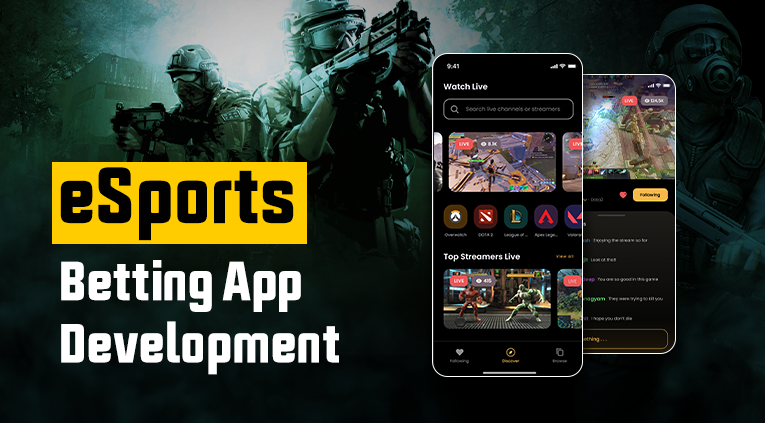In recent times, the eSports industry has been making waves, propelling itself into the limelight and capturing the attention of millions. The concept of wearable devices is a cutting-edge phenomenon all set to revolutionize the world of competitive gaming. These high-tech gadgets, integrated seamlessly into our daily lives, offer an array of functionalities that promise not only to enhance the gaming experience but also to transform the way we approach eSports as a whole.
Wearable technology in eSports? You bet! Picture this: real-time biometric tracking, providing vital insights into players’ physical and mental well-being during intense matches. Imagine the possibilities of augmented reality, overlaying crucial game data and strategies directly onto players’ fields of vision.
And let’s remember the potential for social integration, connecting fans and athletes like never before. As this trend gains momentum, it’s clear that the fusion of wearables and eSports is a match made in heaven, igniting an exciting new era in competitive gaming. This article will discuss the trend of wearable devices for the eSports industry and how it will revolutionize the entire system. Before that, let’s look at some wearable industry statistics.
Wearable Technology In eSports Statistics
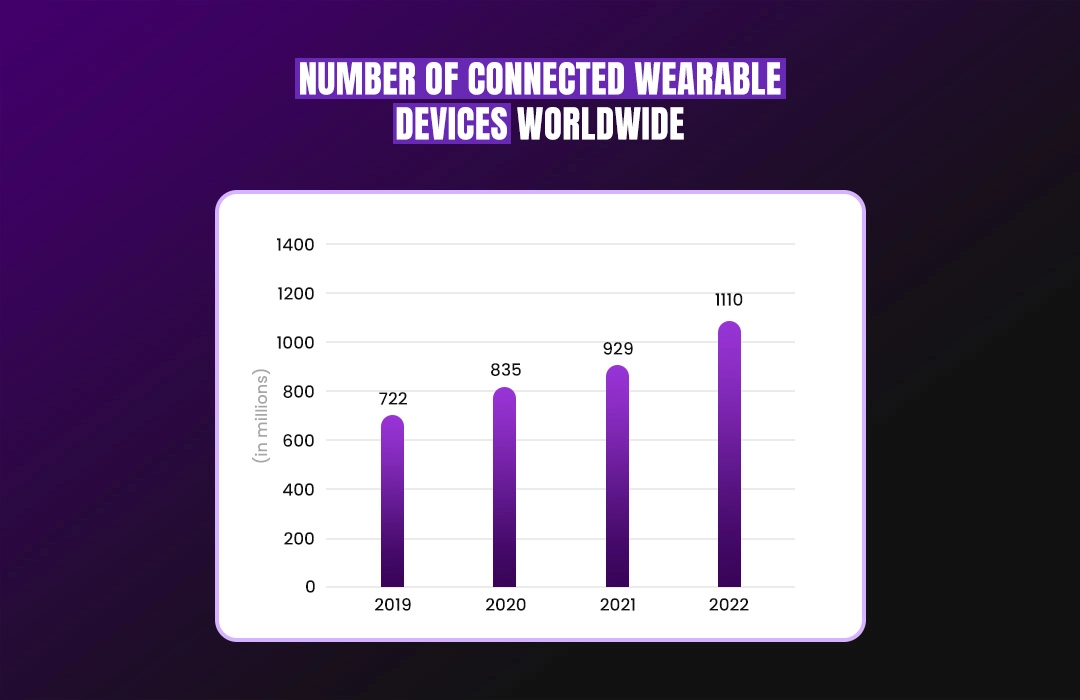
1. According to reports, wearable devices in the sports industry will grow with a CAGR of around 13.5% between 2024 and 2030.
2. In 2021, the market of wearable devices in the eSports industry was around $79.4 billion, and it’s expected to touch the mark of $212.67 billion by the end of 2029.
3. According to Statista, in 2021, the number of connected wearable devices was 929 million, which will surge to 1.1 billion by 2022 end. In 2024, this number of wearable devices is expected to grow substantially.
On this note, let’s look at some crucial aspects that are making wearable devices highly popular in the eSports industry.
Why Is Wearable Technology Getting Massively Popular Among eSports?
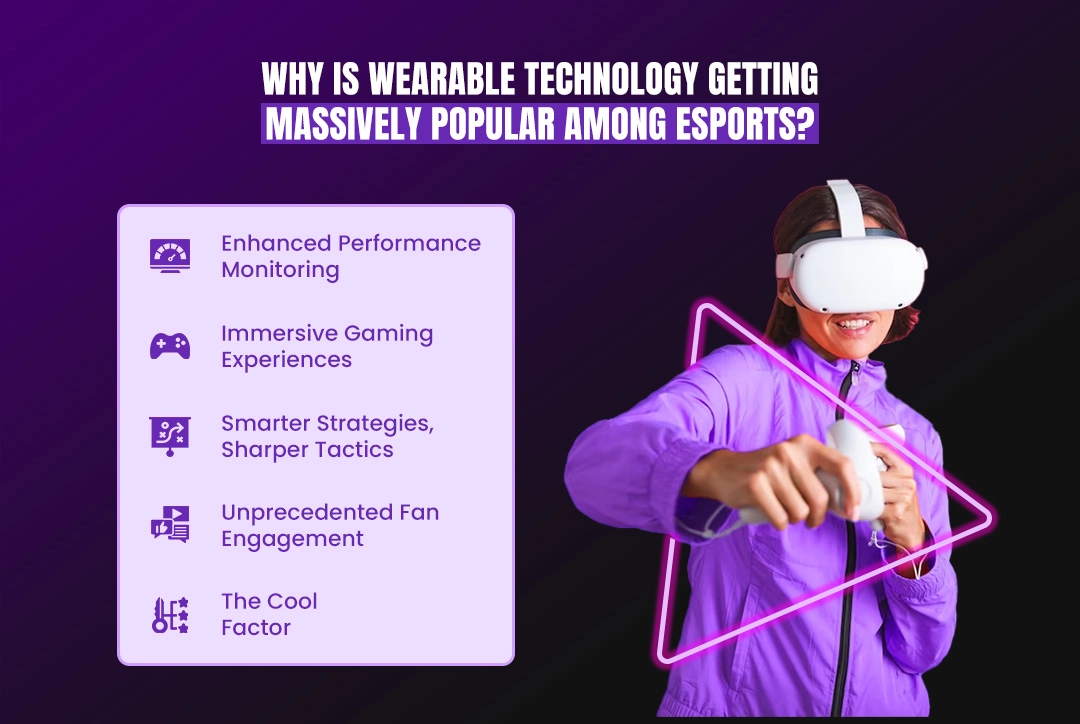
Enhanced Performance Monitoring
Wearable technology tracks and analyzes player performance, offering a treasure trove of valuable data. From heart rate to stress levels, these devices vividly depict an athlete’s physical and mental state during high-pressure matches. As a result, coaches and players can fine-tune training regimens, minimize fatigue, and optimize their performance, ultimately leading to a more competitive and exhilarating eSports landscape.
Immersive Gaming Experiences
Imagine the thrill of being “inside” your favorite game, feeling every pulse-racing moment with unparalleled intensity. This fantasy is quickly becoming a reality for eSports enthusiasts thanks to wearables like VR headsets and haptic feedback suits. By blurring the line between the digital and physical worlds, an eSports wearable device ushers in a new era of immersive gaming that captivates audiences and players alike.
Smarter Strategies, Sharper Tactics
With the advent of augmented reality wearables, players can access real-time information and insights that dramatically shift the tide of battle. Overlaying crucial game data, such as enemy positions or resource locations, directly onto players’ fields of vision allows for quicker decision-making and seamless execution of strategies. It’s a game-changer, literally.
Unprecedented Fan Engagement
Wearable technology bridged the gap between fans and players, fostering a sense of camaraderie and shared excitement. Imagine wearable devices that let fans interact with players through social media or virtual events. The possibilities for connection are endless, ushering in a new age of fan loyalty and community-building.
The Cool Factor
Let’s face it: wearable technology is undeniably cool. Futuristic designs, sleek interfaces, and cutting-edge features make these devices irresistible to gamers and tech enthusiasts. As the eSports industry continues to evolve, wearable tech’s allure will only grow stronger, capturing the imagination of a new generation of players and fans.
Now, let’s explore how the wearable industry is revolutionizing eSports with its modern tech advancements.
How Is Wearable Technology Changing the eSports Industry?
The eSports industry has experienced unprecedented growth in recent years, with millions of fans worldwide tuning in to watch their favorite players and teams compete. With advancements in technology, the landscape of eSports is constantly evolving.
One such technological development is wearable technology, which has significantly impacted the eSports industry. We’ll explore how wearable tech is changing the game for professional players and fans alike.
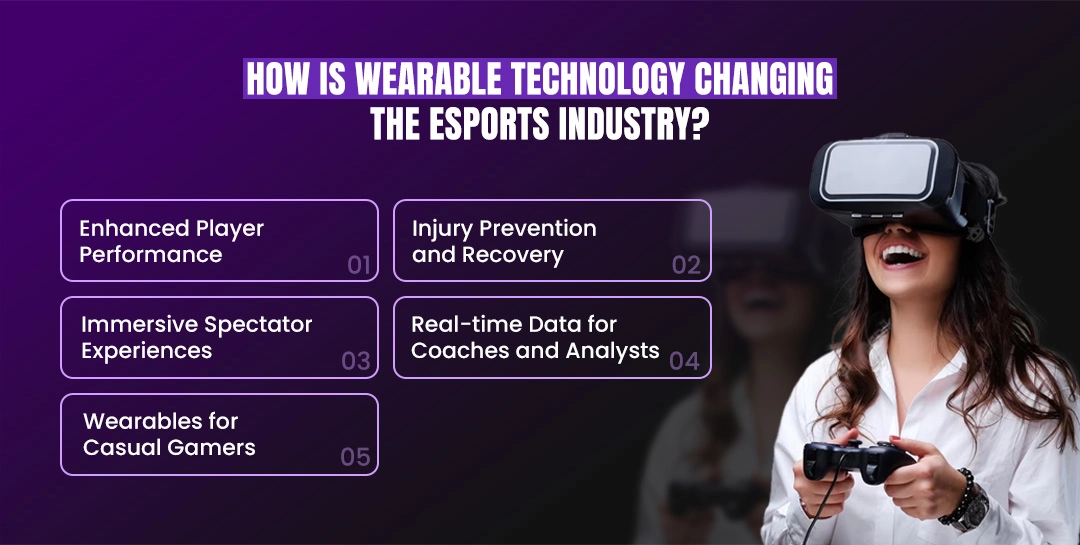
Enhanced Player Performance
Wearable devices can monitor a player’s physiological data, such as heart rate, body temperature, and stress levels. This information allows players to optimize their training regimes, identify areas to improve and manage stress effectively.
For example, wristbands with sensors track players’ vital signs during practice sessions and matches, providing real-time feedback. This data helps players make informed decisions about their physical and mental well-being, allowing them to perform at their peak consistently.
Injury Prevention and Recovery
Injuries can be devastating for professional eSports athletes, whose careers often depend on their ability to maintain peak performance levels. Wearable technology can help prevent injuries by monitoring players’ physical condition and providing early warning signs of potential issues.
Smart clothing with embedded sensors can detect muscle imbalances or poor posture, allowing players to address these problems before they lead to more severe injuries. Additionally, wearables can aid in the recovery process by tracking rehabilitation progress and ensuring that players are not pushing themselves too hard too soon.
Immersive Spectator Experiences
Wearable technology is not only beneficial for players but also for fans. For instance, virtual reality (VR) headsets can transport eSports spectators directly into the gaming arena, providing an immersive and interactive experience like never before.
Fans can enjoy a first-person perspective of their favorite players, follow the action from multiple angles, and even participate in virtual meet-and-greets with eSports stars. This heightened level of engagement strengthens the connection between players and their fans, creating a more dynamic eSports community.
Real-time Data for Coaches and Analysts
Coaches and analysts play a vital role in the success of an eSports team, and wearable technology can provide them with valuable insights to inform their strategies. By monitoring players’ biometric data during practice sessions and live matches, coaches can identify patterns, strengths, and weaknesses.
This real-time data lets coaches decide on player substitutions, in-game strategy adjustments, or tailored training programs. Ultimately, this information helps teams gain a competitive edge over their opponents.
Wearables for Casual Gamers
The impact of wearable technology extends beyond the professional eSports scene, as casual gamers can also benefit from these devices. Fitness trackers and smartwatches can help gamers monitor their physical activity, encouraging them to take breaks and maintain a healthy lifestyle.
Moreover, some wearables are designed for gaming enthusiasts, offering in-game notifications and customized haptic feedback features. These devices enhance the gaming experience for casual players, further bridging the gap between eSports and mainstream audiences.
Wearable technology has undoubtedly changed the landscape of the eSports industry. Wearables can revolutionize how we engage with competitive gaming, from performance enhancement and injury prevention for professionals to immersive experiences for fans and benefits for casual gamers.
As technology advances, we can expect even more innovative applications of wearables in eSports. On this note, let’s explore how much it costs to build a custom eSports wearable app.
Benefits Of Wearable Technology In eSports
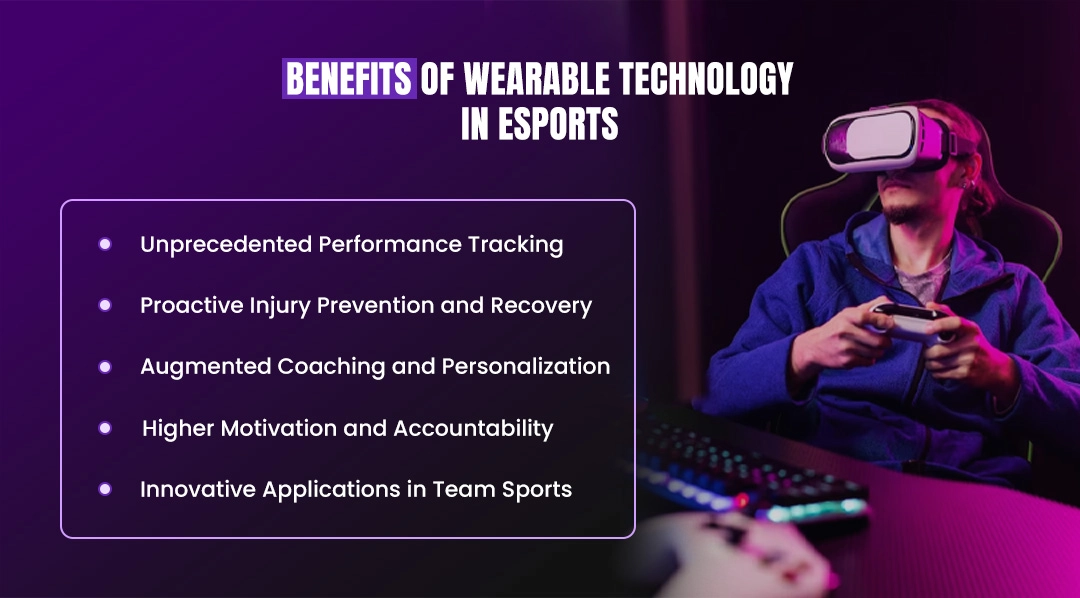
Unprecedented Performance Tracking
A significant merit of wearable technology lies in its capacity to provide athletes with intricate insights into their performance. Devices such as GPS-enabled watches, heart rate monitoring devices, and fitness trackers deliver instantaneous feedback on a plethora of metrics, encompassing distance traversed, velocity, and caloric expenditure.
Proactive Injury Prevention and Recovery
Innovative wearables equipped with cutting-edge sensors have the ability to sense anomalies in an athlete’s motion, posture, or muscular activity. By pinpointing potential areas of concern, these gadgets aid in mitigating the likelihood of injuries caused by overexertion or incorrect technique.
Augmented Coaching and Personalization
Wearable technology lets athletes have the opportunity to receive tailored coaching that caters to their unique needs. By collecting and analyzing individual performance data, these devices facilitate the formulation of customized training plans designed to optimize results.
Higher Motivation and Accountability
The fusion of wearable technology with sports has engendered a boosted sense of motivation and accountability among athletes. Wearables encourage users to establish and pursue fitness goals by rendering their progress tangible and easily trackable. Additionally, social features integrated into many devices enable users to connect with like-minded individuals, participate in challenges, and share achievements.
Innovative Applications in Team Sports
Wearable technology has not only benefited individual athletes but also revolutionized team sports. Devices capable of monitoring an entire squad’s performance data allow coaches to evaluate each player’s strengths and weaknesses, devise targeted training regimens, and make informed decisions regarding tactics and player selection.
Pros and Cons of Wearable eSports App Development
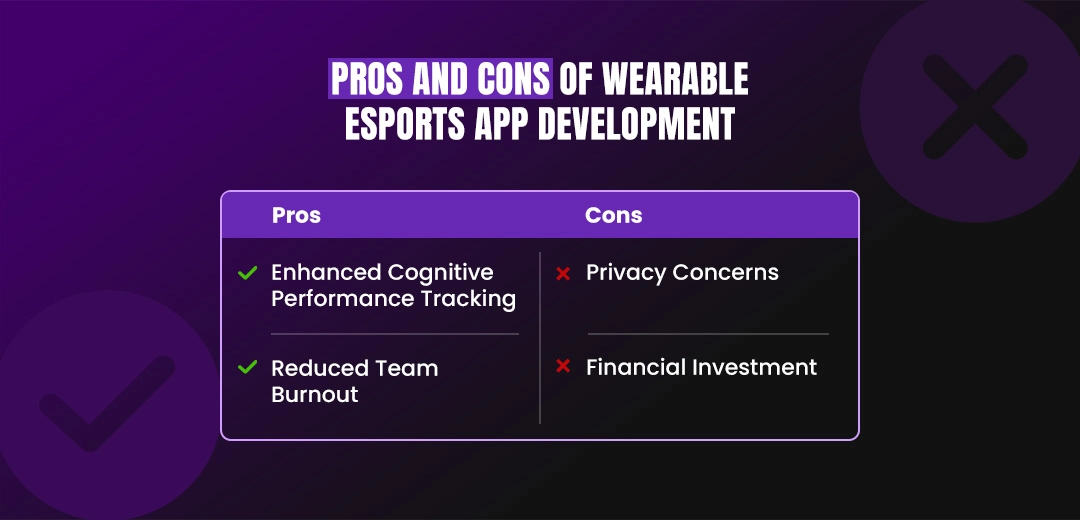
Pros:
Enhanced Cognitive Performance Tracking: Wearable eSports app development enables players to monitor their cognitive performance meticulously. This technology measures reaction time, decision-making speed, and mental stamina, providing invaluable insights for both individuals and teams. Consequently, players can identify areas for improvement and devise targeted training strategies.
Reduced Team Burnout: Implementing wearable technology in eSports app development allows teams to gather data on player stress levels and fatigue. By identifying the early warning signs of burnout, coaches can create personalized training schedules and rest periods to maintain peak performance levels throughout the season.
Cons:
Privacy Concerns: Integrating wearable devices into eSports app development may raise privacy concerns among players. The continuous monitoring and collection of personal data might cause discomfort and apprehension, potentially affecting performance and team dynamics.
Financial Investment: Developing a wearable eSports app requires significant financial resources. Teams must invest in cutting-edge hardware and software solutions, as well as ongoing maintenance and updates.
How Much Does It Cost To Develop A Wearable App?
When delving into wearable app development, one cannot overlook the significance of the cost factor. The financial aspect of developing a wearable app is influenced by numerous factors, making it challenging to pinpoint an exact figure. Nevertheless, understanding these variables will allow businesses and entrepreneurs to make informed decisions when allocating resources for their wearable app projects.
The complexity of the desired app plays a vital role in determining its development cost. Simple apps with minimal features and essential functionality may be more affordable to develop. On the other hand, sophisticated apps with intricate designs and advanced capabilities can quickly escalate the budget.
Furthermore, the choice of platform – whether Android or iOS – can also impact the overall cost, as each system has its own unique set of requirements and development processes that must be carefully considered.
Other vital components affecting the price of wearable app development include the geographic location of the development team, their level of expertise, and the time frame for project completion. Hiring developers from regions with lower living costs can result in significant savings.
On average, the cost to build a wearable app will range between $30,000 to $60,000. It’s essential to hire an experienced app development company like Auxano Global Services to achieve the maximum ROI.
Auxano Global Services Experience in Wearable Tech for Sports
Auxano Global Services, a leader in the realm of technology, holds strong expertise in wearable tech for sports. Our vast experience encompasses not only the development of cutting-edge software but also a deep understanding of athletes’ needs. By striking the right balance between simplicity and sophistication, we can develop software that empowers athletes to push their limits and monitor their performance with ease.
Moreover, Auxano’s innovative spirit, coupled with our unwavering commitment to excellence, has led to the creation of game-changing solutions that continue to revolutionize the world of sports.
We Take Care Of The Data Privacy Concerns In Wearable Software Development
In today’s rapidly evolving digital landscape, data privacy has become a matter of paramount importance, particularly in the field of wearable software development. We recognize these concerns and are devoted to ensuring that our client’s sensitive information remains secure and uncompromised.
As we develop cutting-edge software solutions for wearables, our team meticulously weaves in robust security measures and safeguards user data from potential threats. Simultaneously, we adhere to stringent privacy regulations and industry best practices, thereby fostering an environment of trust and confidence. By adopting this conscientious approach, we aim to provide seamless and secure experiences, allowing users to enjoy the benefits of innovative technology without compromising their privacy.
Why Hire Auxano Global Services For Wearable App Development?
Navigating the intricate world of wearable app development can be daunting, making it crucial to enlist the expertise of a reputable company like Auxano Global Services. By collaborating with our seasoned team, you’ll benefit from our extensive experience developing cutting-edge wearable apps that cater to diverse needs and industries.
Combining our technical expertise, creative design, and a deep understanding of user experience ensures that your project will meet and exceed expectations. Moreover, our commitment to transparent communication and a client-centric focus guarantees a seamless development process.
Ultimately, partnering with Auxano Global Services for your wearable app development venture will result in a high-quality, innovative product that sets you apart in the competitive landscape of wearable technology.
Wrapping up!

Wearable tech is a true game-changer. As eSports expands, these cool gadgets are embraced. Players monitor their health and train smart, achieving more than ever before. Every detail matters in eSports, and wearables are the key. No longer just for fitness lovers, they help unlock hidden potential in players. Wearables make games feel alive, putting them at the heart of the action. The future of eSports is dazzling, all thanks to wearable technology.
Frequently Asked Questions
-
1. What Is Wearable App Development?
Wearable app development is creating applications specifically designed to run on wearable devices like smartwatches, fitness trackers, and smart glasses. These apps, quite remarkably, enhance the user experience by providing quick access to information and personalized features.
-
2. How Do I Start Developing A Wearable App?
Embarking on your wearable app journey begins with an idea! Once you’ve got that, it’s crucial to research your target audience, select the right platform (such as Android Wear or watchOS), and learn the SDKs and programming languages for that platform. Or you can hire an experienced company to develop your eSports wearable app.
-
3. Are There Unique Challenges For Wearable App Development?
Wearable app development faces some distinct hurdles, like limited screen real estate, less processing power, and shorter battery life. To overcome these, developers must prioritize essential features, optimize performance, and ensure energy efficiency.
-
4. How Can I Ensure My Wearable App’s Success?
To boost your eSports wearable devices’ app success, focus on user experience, simplicity, and relevance. A well-designed, intuitive interface and features catering to users’ needs will make your app stand out.
-
5. How Much Does It Cost To Build An eSports Wearable App?
The cost to build a custom eSports wearable app will cost you between $30,000 to $60,000, depending on various complex factors.



![How Much Does It Cost to Develop a Fantasy Rugby App? [2023]](https://www.auxanoglobalservices.com/agsresources/wp-content/uploads/2023/08/Cost-to-Develop-a-Fantasy-Rugby-App.jpg)
